When choosing something that will keep your fish tank clean you’ll need a little more than just a product description.

For this reason, I’ll share some actual experience and what I think is the best aquarium canister filter for your system at home.
In my reviews, I’ll cover some decent external filters to get on a budget and some of the premium units which are mandatory for heavily-stocked fish tanks.
The goal of this article is to make you confident in your final decision.
Let me show you what you should look for in a canister filter for a freshwater aquarium with plenty of fish and how to choose the best one for your setup?
Short overview of my reviews
I’ve owned most of the filters reviewed here and did an extensive amount of research on the few I haven’t owned. Two brands really stood out to me, namely Eheim and Fluval.
- Fluval’s canister filters are of high quality and employ more innovative tech when building their products. Their 07 Series are what you’d get as premium equipment for medium-sized aquariums.
- Moving on, I’d rank Fluval’s FX Series as high-end canister filters for large aquariums. Enormous horsepower and cool features.
- Eheim, on the other hand, lack any unnecessary bells and whistles and rely on practical efficiency. Eheim are probably the longest-lasting filters in the industry. As a matter of fact, any canister filter that comes from Eheim or Fluval will be durably and mostly quiet.
- Next is the Penn Plax Cascade which is, rightfully so, the most sold canister filter. It has the perfect ratio between price and value. However, this also means it excels at neither.
- The Polar Aurora filters are the budget option coming from China. You can’t expect them to last as much as the others mentioned here. However, with proper care, they can probably stay with you for as long as 2 years.
- Finally, although the Aqueon QuietFlow 400r doesn’t stand out with anything particular like the rest its overall score is pretty decent. Hence it made it into my classation and it’s still one of the best canister filters out there, in my view.
Take a look at a comparison chart of the canister filters I reviewed:
| Canister Filter: | For Freshwater Aquarium Size: | Price Bracket: |
|---|---|---|
| 1. Penn Plax Cascade Canister Filter Series | 30 to 75-gallon aquariums | $$ |
| 2. Eheim Classic 22(XX) External Filters | 10 to 55-gallon aquariums | $$ |
| 3. Polar Aurora | 40 to 75-gallon aquariums | $ |
| 4. Fluval X07 External Aquarium Filter | 20 to 55-gallon aquariums | $$$ |
| 5. Fluval FX(X) Aquarium Canister Filter | 75 to some understocked 125-gallon aquariums | $$$$ |
| 6. Aqueon QuietFlow 400 Canister Filter | 55 to 100-gallon aquariums | $ |
| 7. Eheim Professional 4+ | 30 to some 60-gallon tanks that are very heavily stocked | $$$$ |
How to Choose a Canister Filter for Your Aquarium?

External filtration is a must-have hardware in all aquarium systems. But why is that?
Before I start reviewing products, I must walk you through these factors.
Follow these steps to choose a canister filter that will work well for your aquarium:
1. Consider livestock and bioload.
The type of livestock you keep is 50% of your decision on a canister filter.
- The size of your fish also plays a role in your pick. I’ve noticed that smaller fish can either get blown around or sucked in by a stronger filter. Larger fish often prefer a slower current. Fish like Betta fish, angelfish, and other long-tailed species may have difficulties swimming in a stronger current. Most bottom dwellers like a good current;
- The mess your fish make has the greatest impact on your pick of a filtration system. When I used to keep larger Goldfish I quickly realized that they are notorious for the mess they make and require stronger filters. The large 100%-carnivorous fish within my predatory aquariums would produce huge amounts of waste as well. For this reason, if you plan on keeping a freshwater eel, cichlids, Oscars, or Piranhas, a highly-rated canister filter is a must. This, in combination with your fish tank’s size, will determine the water turnover you’d want to have in your system.
- When dealing with a heavily planted tank you’d look for something that will move around carbon dioxide.
Author’s note: An oversized filter won’t be able to prevent the growth of hair algae if your tank’s water is oversaturated with organics from the messy fish.
2. Take into account the size of your tank.
The dimensions and gallon capacity of your aquarium will determine how much water you’d want to be turned per hour.
I would usually recommend that you look for at least 4 times of water turnover per hour with canister filters.
However, according to your livestock, this number can be increased to 6 or 7 with larger, messier aquarium fish (see the previous section on livestock).
Different canister filters have different GPH (gallons per hour) / LPH (liters per hour) turnover ratings.
I have found that depending on the motor of the canister filter, the advertised number may get reduced by up to 60% when you add filter pads, rockwork, aquatic plants, and aquarium fish.
This is the reason I usually recommend that people get a canister filter rated for fish tanks that are twice as large as theirs. Every experienced fishkeeper will likely agree with me.
Note: “for XX-Gallon Tanks” ratings that you see on the label and GPH rate are two separate characteristics.
For example, two separate canister filters may have the exact same GPH (say, 100), but one can be rated for 75-gallon tanks and the other for 90-gallons.
That’s because the “recommended for” rating is done by the manufacturer and is based on their subjective estimates. It should not be blindly trusted.
3. Bear in mind the manufacturing architecture.
The way a canister filter is assembled plays a great role in its durability and efficiency.
I won’t go into details (as I’m not that tech-savvy), but a good indication here can be the brand of the canister filter.
There are brands that have been tested by thousands of fishkeepers throughout the years and eventually stood out.
A well-built filter will have sturdy parts, unsusceptible to breaking or malfunction.
The architecture will also determine the loudness of a canister filter during work.
4. The pumping motor and its impeller should be reliable.
The rotor of a canister filter is its heart and soul.
Given that I’d only turn the filter off during maintenance, a strong and durable impeller is a must for me.
All of the filters I am reviewing here have great motors, as expected. The motor is the only moving part inside your canister filter.
There are two types of motors that canister filters employ:
- One is an epoxy-sealed motor. A particular feature of these motors is that the impeller is positioned upside-down. This in itself is a practical solution to moisture and debris, that can hinder proper function. These motors rely on electricity powering a magnetic coil, which in turn rotates the impeller;
- The other type is a motor that’s magnetically driven. Although these motors also utilize a magnetic coil for their spin there are a couple of major differences to be pointed out. One is that these motors are self-priming. I really appreciate this type of motor, because, for me, priming is by far the most annoying feature of canister filters. On the other hand, the impellers of these motors are exposed to more debris and may get clogged faster. Nothing to be scared of, as with proper maintenance these motors can actually save you the hassle.
Anyway, the sealing in a motor is its second most important feature.
During my research before I got my first canister filter, I found out that worn-out rubber O-rings are the main reason for leaks.
Fortunately, replacing them is not something hard or expensive.
Here’s a pretty good video on motor maintenance that I wish more people would see:
It’s only 7 minutes long but it will absolutely clarify the basics of how motors work.
5. Sealing is what prevents leaking.
My filters are circulating hundreds of gallons of water daily. I don’t want that water to end up on my floor.
The valves in a canister filter can be the difference between a year-long service and costly part replacements.
Though the models mentioned below all stand out with excellent sealing I am obligated to mention this, in case you decide on another product.
6. Be aware of the potential loudness during operation.
One of the most enticing features in canister filters is how quiet they operate, unlike their HOB counterparts.
However, there are models that will be noisier than others.
This is not to a significant extent as they are all pretty quiet.
Yet if you consider yourself a super light sleeper and you keep your fish tank in the bedroom there are models that will suit you better.
Some canisters are virtually silent. I’ve done noise reviews on a couple of ones and the quietest turned out to be:
- Eheim Classic
- Fluval 07 and FX Series
- Penn Plax Cascade
- …
Light sleepers or people who don’t like background humming noises can check the remaining 4 in the article I wrote when I was on the quest of finding the quietest aquarium filter.
In case you don’t have the time to skim through that guide, look up the sound-dampening motor feature in the description of your unit of choice. Most canister filters by Fluval, for example, will have that.
7. Disassembling a unit for maintenance may take some time.
For me, this is probably the only overall con of canister filters.
Though MOST of them are designed with the idea to be taken apart easily, it takes me time.
When you’re considering a canister filter for your freshwater aquarium you should be prepared for what comes with that.
In my opinion, for the type of aquarium filtration these filters provide, the 20 minutes of cleaning are well-worth it.
Suggested read: How Long Can Fish Survive Without a Filter Working in Their Aquarium?
8. Some units can have bulky dimensions.
What I consider to be one of the main advantages of canister filters is that they offer plenty of room for filter media.
It’s a blessing and a curse.
By having a lot of media you make sure that the fish tank can be overstocked, without worrying about crashing the Nitrogen cycle.
However, some units can be quite large – something you cannot really tell from their stock photos.
Do check the dimensions in the description, if you’re browsing aquarium filters online.
9. The more room for filtering media – the better.
A canister filter offers multiple stages of water filtration.
The larger devices will have up to 6 trays for filter media. My experience with larger fish shows that the more bed for the beneficial bacteria in my aquarium I provide – the merrier.
The volume a media tray provides will also vary with each canister filter. Some units will be just huge, offering plenty of space for housing nitrifying bacteria.
Smaller filter trays lead to more often cleaning, likely because of the accumulation of Nitrate in the fish tank’s water. A larger media tray will not clog with gunk too quickly, allowing more flow that would move the Nitrate around to be used by your aquatic plants, for example.
Anyhow, a quick hack I found is to use inexpensive filter floss that will make your aquarium water crystal clear within hours.
Really great for planted tanks as well.
I’d put a considerable amount in my canister filters and change it every 2 months to absolutely polish my aquarium water.
You can also use the stuff as your sole media for biological filtration.
The 7 Best Aquarium Canister Filters: My Reviews
A bulky aquarium filter will likely guarantee good water quality through its strong circulation and additional space for the biofilter bacteria. Below you’ll only find reviews of models that I’ve personally used or have seen work in the systems of my friends and clients. These are the best canister filters for a freshwater aquarium:
1. Penn Plax Cascade – Most Popular Choice
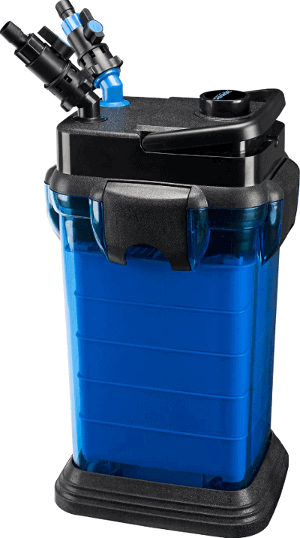
Click to compare pricing + see MORE photos of this product at:
My first impression of this unit was that it was kind of ugly-looking. However, this duckling definitely surprised me in terms of performance and durability.
The Penn Plax Cascade aquarium canister filters have absolutely exploded in the fishkeeping world in recent years. When I was doing the research before getting myself one, I discovered that they were probably the top-rated aquarium filter for medium to large freshwater fish tanks.
Depending on the model the Cascade will have between 2 and 5 stages of filtration. That, along with how spacious the filter trays are, allows us aquarists to be as flexible as we want with our filter media of choice.
Another feature that kind of won my heart is how this canister filter is built.
Unlike most cheaply built brands, the manufacturers of the Cascade use a special kind of sturdy plastic that makes these aquarium filters very sturdy.
As small-ish plastic parts are the first thing to break in a canister filter, this comes off as a huge advantage, at least for me.
Anyhow, what gave me the inspiration to end up with one was that the Cascade series are absolutely customizable.
You get to play with your desired flow rate and the valves are able to rotate 360 degrees each.
For me, this meant that I could position the cartridge wherever I wanted and also, protect my slow simmers if they were to dislike the stronger water current.
After I got my first Cascade I was pleasantly surprised at how easy it was to install the unit.
I think that if you’re a total novice in canister filters you will manage to set it up from the first time.
Having tested many brands throughout the years, I consider this canister filter the most novice-friendly in that regard.
You will also experience the benefit of a self-priming motor.
Manual priming is usually the most annoying disadvantage of canister filters, as I’ve already pointed out.
Anyway, all of the aforementioned comes along with an excellent level of filtration from this canister filter.
Advantages:- Highly customizable (flow rate included);
- Comes with a spout outlet and a spray-bar;
- Up to 5 stages of filtration;
- Self-priming button;
- Easy to disassemble;
- Sturdy plastics;
- Quiet;
- Straight-forward instructions;
- Comes with carbon filtration.
- Not all of the water passes through the trays (given the flow rate potential, this is not really an issue);
- Not as long-lasting as other filters;
- The handle may not be strong enough to carry the unit.
2. Eheim Classic Series – Long-lasting
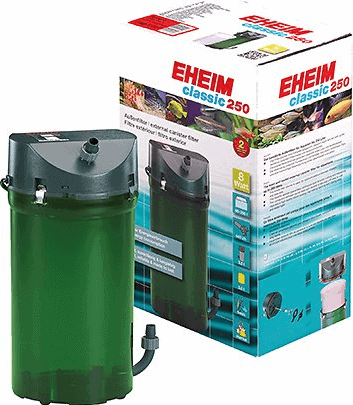
Click to compare pricing + see MORE photos of this product at:
The Eheim Classic external canister filters have been around the aquarium industry for quite some time.
They are not a new model but have managed to survive the test of time on the market.
In my experience this may be because there are certain things that only an Eheim aquarium filter will provide:
The Eheim Classic aquarium canister filters boast excellent durability for their price while being easy to maintain (something that’s not often seen with large external filters). They also have more space for filter media and a flow rate that’s not super strong. This makes them one of the best choices for messy, long-finned fish such as goldfish and Oscars.
On the other hand, Eheim as a brand holds positions among the best canister filters suitable for small and large aquariums.
This is likely because the 22xx Series have a solidly assembled structure that results in impressive longevity. Here are all the notable models in said 22xx Series:
- 2211
- 2213
- 2215
- 2217
- 2260
- 2262
Author’s note: The 2260 and 2262 are not part of the Classic Series and they suit a very large aquarium.
Anyway, I’ve found that it is not uncommon to have an Eheim run flawlessly for over 10 years. This has been my experience, but if you do a little research you’ll find that to be true for many other users.
For the price tag, these aquarium filters are probably your best long-term investment (for serious fishkeepers only!).
I’ve had the pleasure to own a couple of Eheim units throughout my years of keeping fish.
In my experience, the advertised filtration of the units gets reduced the least with adding filter media.
They are really quiet and can be used for aquarium systems that stay in bedrooms.
Advantages:- Enormous space for filter media which helps with keeping an overstocked fish tank cycled;
- Stunning longevity of the units;
- Permo-elastic silicone sealing (fancy speak for “no leaks”);
- Comes with the various useful media upon purchase;
- Easy on the maintenance part;
- Simple installation;
- Exceptionally quiet operation.
- Overall lower GPH for the price (which can be good for beneficial bacteria);
- The motor is not self-priming;
- The manuals are garbage (just watch a video online on how to set it up).
3. Polar Aurora – Cheaper Alternative
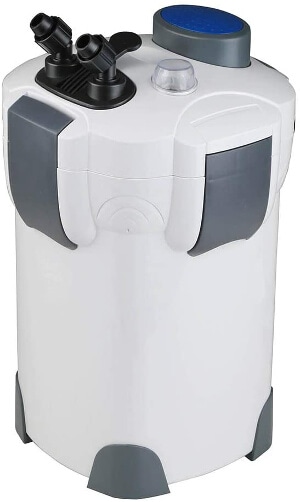
Click here to check pricing + see MORE photos of this product at Amazon.com
Coming from China, you may also find these canister filters under the brands of Polar Aurora or Aquatop.
Anyway, the Polar Aurora canister filters are suitable for anyone with a larger aquarium on a tighter budget. This is because these external filters provide the best water turnover for the money.
Since they’re manufactured in China you don’t really pay for the name of a famous brand.
What I also like about them is that they will come in a full kit, unlike some of the other more popular canister filters.
Ordering one will land you 6 filter pads (2 coarse and 4 medium ones), some bio balls, ceramic bio-rings, and a 9-Watt UV light for sterilizing water.
Author’s note: A UV sterilizer is a device that irradiates the water with UltraViolet light and kills pathogens and other nasties that may plague your aquarium’s water. Typically I’d recommend that you get a standalone UV sterilizer if you have issues with the water in your fish tank. You can learn more about the best UV sterilizers for clearing aquarium water by clicking here.
Anyway, for what it’s worth, none of the other canister filters mentioned here come with a built-in UV sterilizer.
This filter’s box even includes a bonus of activated carbon media, which is great if you’re not into running separate GFO and carbon media reactors.
Anyhow, the Polar Aurora canister also has a priming button. From what I’ve seen, you only need to press it a couple of times, when there’s air inside the unit.
A con of this slightly cheaper canister filter is that the instructions for the setup seem like a literal translation from online software. In places, the text doesn’t make any sense in English.
Don’t get me wrong, there are some negatives here, as with all products.
The Polar Aurora canister filters are not as durable as other devices coming from more reputable brands.
Unlike Fluval and Eheim, you’d need to take really good care of your Polar Aurora filter to help it reach the 2-year lifespan mark.
Author’s note: The Polar Aurora model that’s advertised to offer 525 GPH won’t really meet that. Still, it will turn over around 300 gallons per hour, which is more than enough for a 55-gallon tank that’s reasonably stocked with aquarium fish of all types.
Anyway, these canister filters also run absolutely silent, which is why I included them in my other guide on the quietest aquarium filters.
I use one such filter on my larger fish tank as supplementary filtration and I’m pretty happy with it.
Author’s note 2: Don’t run the UV sterilizer for more than 24 hours. It will eat through the plastic of the filter trays. I run mine on the weekend for about 4 to 6 hours a day. This is more than enough for it to get rid of any floating algae spores and harmful microorganisms.
Advantages:- Best GPH rate for the money on the market;
- Comes with a UV sterilizer;
- Virtually silent;
- Multiple stages of filtration;
- Comes with activated carbon and plenty of filter pads;
- Self-priming button.
- Not as durable and long-lasting (short warranty);
- Instructions are basically useless (watch a video on how to set it up instead);
- UV sterilizer should not run for a long time;
4. Fluval 07 Series – Extra Features & Performance
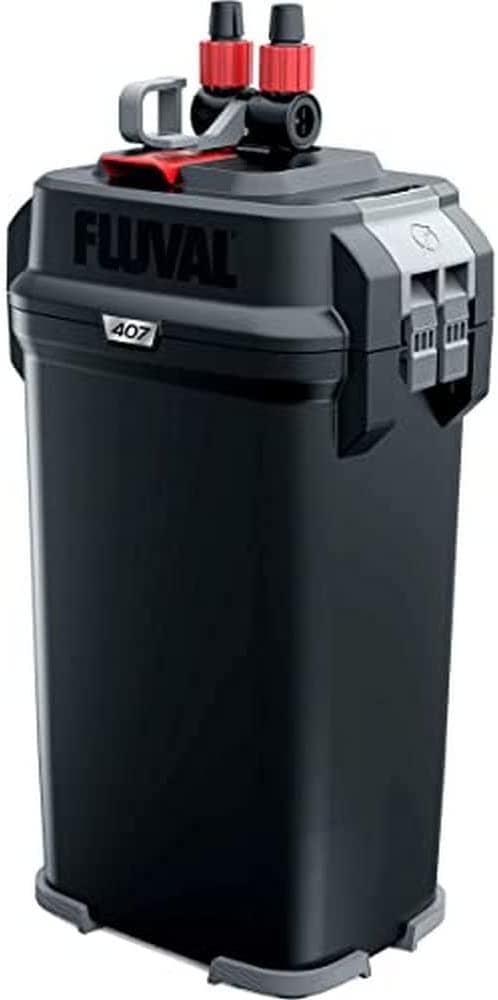
Click to see the current price + MORE photos on Amazon.
From what I gathered from my research on these products Fluval along with Eheim is the top choice among experienced aquarist.
Naturally, Fluval filters are just a tiny bit pricier than Eheim, but from what I later saw (and experienced first hand) for a good reason.
The Fluval 07 series offers excellent filtration along with extreme durability. These canister filters have a really sturdy architecture, manufactured by the best parts on the US market. This alone makes them a good choice for a high-end water filter in freshwater aquarium systems of up to 55 gallons.
From my observation, the sealing of the 07 Series is near impervious. The chance of a leak is probably nonexistent and neither I nor my friends have had one with these filters.
I also find that the maintenance is a breeze and it’s rarely needed with these canister filters.
The other thing that really stood out to me when I got mine was the motor.
All of the 07 Fluval canister filters have enormous filtration capacity. The GPH advertised is as realistic as it gets.
As far as my experience goes, you will enjoy the least GPH reduction after adding livestock and filter media to the equation (as with an Eheim).
The motor also has sound-dampening features to minimize vibrations during operation.
Personally, I’m not bothered by white noise.
However, if your houseguests hang out in the room where the aquarium is, you’d want your canister filter to have the sound-dampening technology.
Anyway, I can’t really find a weak spot to point out with these, so if you have the financial opportunity – simply get this canister filter for your aquarium.
By the way, Fluval is also famous for their excellent customer service, should you ever need it.
Advantages:- “Aquastop” valves that ensure no water is spilled during maintenance;
- Sound-dampening motor for extra quiet operation;
- Will last you years;
- Pumps tons of water and is really efficient;
- Excellent unit architecture with top-notch parts;
- Huge space for filter media.
- Not the easiest to start and prime (watch some video online for that but there are plenty).
5. Fluval FX Series – The POWERHOUSE

Click to see the current price + MORE photos on Amazon.
There are two filters that fall in these series and namely the FX6 and the FX4. For tanks that hold less than 70 gallons of water these canister filters would be overkill. I would not be exaggerating if I were to say that the FX filters are just full-blown monstrosities.
The filters from the FX Series are more than twice as powerful as their cousins from the 07 Series.
The difference between Fluval’s FX4 and their FX6 is that the FX4 has a power of 100 GPH less its bigger brother, down from FX6’s 563 GPH. Aside from that the FX6 has an enormous cartridge that can hold roughly 50% more filter media than the FX4.
The FX6 has the most pumping capacity on this list (rated for up to 400-gallon aquariums). The only alternative to Fluval’s FX6 I can think of in that regard is the enormous Eheim 2262 which is not listed here.
Anyway, here’s what makes Fluval’s FX series the best pick for you:
This canister filter is what you get for your large freshwater aquarium that has big, carnivorous fish or turtles in it. The FX external filters are as good as it gets because they offer tons of functionality, which I couldn’t find elsewhere.
If you end up getting something from the FX Series you’ll also get the typical Aquastop valves that allow for care-free maintenance.
From my comparison research, I can tell that the motor of the FX6 is an absolute beast and is likely one of the best on the market. With an actual turnover capacity of over 500 gallons of water, it stands undisputed.
I should probably mention that it comes with not 5, but 6 stages of filtration which gives the flexibility of playing around with all kinds of filter media.
But how did Fluval get away with that?
Well, I figured it – they just put a filter tray within the filter tray.
Something important to remember about all of this is that the basket-like architecture makes sure the water passes through every filter tray and not around.
Both the FX6 and FX4 come with a Smart Pump technology. This tech will effectively self-prime the filter every 12 hours.
Did I mention that I use this filter on my 125-gallon fish tank and I could not be more satisfied?
It runs extremely quiet and it easily handles my very messy Oscars (and not only!).
There is also this additional clog-proofing feature that makes this filter virtually immortal.
You can’t go wrong with getting the FX6 or the FX4, but they come at a price.
Literally.
Not something everyone can afford, but if you’re participating in the large aquarium game that is to be expected and, consequently, needed.
With the Fluval FX Series, you’re paying for a high-end aquarium canister filter with unique functionalities and top-quality service.
Still, given how much it offers the investment is overwhelmingly worth it. I’m positive that in the long run, I ended up saving a fortune.
Don’t just take it from me, ask around your community.
Advantages:- No priming required whatsoever, thanks to the Smart Pump feature;
- Pumps water like a champ;
- Reduced electricity usage, despite the huge water turnover;
- 6 stages of filtration, which no other canister filter has been able to provide;
- Tracks the water flow automatically, adjusts itself when needed;
- Self-Protection: will shut off if something inside of it goes wrong, preventing leaks;
- As quiet as it’s efficient;
- Made to last years;
- Tech features that no other canister filter provides;
- The nozzle can be turned in multiple directions.
- The initial cost of investment (though completely justified);
- Needs considerable space, as the unit is quite large. If you happen to have a stand for your large aquarium it can likely fit in.
6. Aqueon QuietFlow 400 – The All-Rounder

Click to see the current price + MORE photos on Amazon.
The Aqueon QuietFlow canister filters have maintained a well-known brand name in the freshwater fish-keeping community.
The reason for that is their quality service at a reasonable price.
Compared to the premium brands the QuietFlow will come at a price (sometimes) twice as low for the same filtration power. This canister filter also has all the convenient-to-use features such as easy priming, sound-dampening, and whatnot.
Though it may not be made of sturdy plastic, the Aqueon canister filter is definitely the superior choice when maintaining a larger aquarium on a budget.
I wouldn’t hesitate to use these on 55 to 75-gallon fish tanks. In fact, I’ve successfully used the QuietFlow 400 on a 75-gallon planted aquarium that had a decent bioload.
The motor is powerful and pumps huge water amounts, as advertised. The 400 version has a turnover capacity of 400 GPH, and you won’t find another canister like that for the same price.
I also like this filter’s care-free priming technology, combined with the quick-disconnect valve. The first is really efficient and the second allows cleaning of the device without the need for serious re-priming.
I keep saying that priming is very annoying, but here that is completely eliminated.
The disadvantages of this unit are its stiff hoses and the not-so-quiet operation.
I researched this aquarium filter heavily before getting it, and I’ve found that some people hear a slight humming whereas others would swear that it’s completely silent.
In my experience, you would not hear it if you keep it inside a cabinet. it’s way quieter than a HOB filter, it’s just not virtually silent as other filters that I’m mentioning here.
Speaking of HOBs, the QuietFlow 400 package includes a Hang-on-Back unit for water polishing which, given the price tag, is more than fantastic.
My HOB polishing unit seemed to do its job at keeping my aquarium water crystal clear, while the QuietFlow would relentlessly pump and filter out debris.
What I’d like to mention is that though the installation is pretty straightforward for the canister filter world the hoses can be a pain to connect.
What I ended up doing was soak them in really hot water until they became soft and loose.
I then connected them and when they cooled off, the grip became as strong as ever. Problem solved.
Author’s note: Make sure to fill the cartridge with water before starting the filter. This way the priming will be much, much faster.
Advantages:- Among the top GPH for the price;
- Included HOB water polishing unit;
- Pretty silent for the powerhouse it is;
- No need of re-priming after cleaning, thanks to the quick-disconnect valve;
- Durable design of the basket made to last;
- Longer than usual hoses, for optimal positioning;
- Multiple water return options in the kit, spray bar included.
- Can be difficult to set up the tubing, unless you know how (check the my tips in the review).
7. Eheim Professional 4+ Series – “Set it and forget it” Solution

Click to compare pricing + see MORE photos of this product at:
The marketing campaign behind the Eheim Professional 4+ canister filters will have you believe that with them you get:
- Quiet operation;
- Powerful performance;
- Optimal electricity usage;
- Safety adapter for the hoses;
- the new “Xtender” button;
- Easy priming.
In my experience, everything on this list is spot on except the “powerful” performance.
The manufacturers from Eheim don’t like to publicly disclose their filter’s GPH ratings, but it’s not a secret that their filters are on the weaker end.
I’m assuming the mystery around the GPH is there because Eheim thinks other factors are important for having decent aquarium filtration.
I can’t entirely agree with that.
Mechanical filtration is purely dependent on the GPH rate, but the biological one isn’t.
It boils down to two variables, really:
- Higher GPH means less physical debris in the water and more water cycled through the filter media;
- More filter media means less issues with elevated ammonia levels and the Nitrogen cycle overall.
Following these thoughts, it’s worth mentioning that the most common issues with aquarium filtration do stem from an imbalance in the tank’s biological ecosystem. Things like green algae blooms, white, cloudy water in the fish tank, and ammonia spikes are all examples of that.
However, your canister filter also needs a good GPH rate so that all the water in the tank is timely passed through the filter media.
This ensures the filtering bacteria will do their job effectively.
Anyway, Eheim’s Professional 4+ 600, for example, is roughly twice as powerful as their 2215 Classic one (Eheim Classic 350).
This would mean that the Eheim Pro 4+ 600 packs around 200 GPH of filtering power which, for the price tag, is not at all impressive.
What this canister filter shines with, however, is its enormous space for filter media, its priming aid and its super quiet performance. These three virtually guarantee you peace of mind when it comes to stocking your tank with messy fish.
The Eheim Pro 4+ 600 has 10% MORE filter media volume than even the enormous Fluval FX6.
Also, the self-priming feature of the Pro 4+ canister filters is unsurpassed.
Overall, I would rate the Eheim Professional 4+ as an 8/10 canister filter, taking away two points for the high price tag and the GPH rate.
The new Xtender button is not that much of a big deal, in my observations.
Advantages:- One of the best self-priming features;
- Enormous space for media, which ensures solid bio filtration;
- Works in near-perfect silence;
- Rarely needs cleaning;
- Optimized for using as little electricity as possible.
- GPH rate is on the lower end for this price bracket;
- The media trays are a bit weird to handle and put back together during maintenance.
What size canister filter will best suit your fish tank’s gallon capacity?
I am perfectly aware that it all boils down to one’s aquarium setup.
Because of this, I want to go the extra mile here.
I will recommend a specific canister filter for each possible aquarium setup, according to my experience and observations.
For optimal recommendations, I am considering fish tank sizes, livestock, and aquascape, combined with the pros and cons of the particular canister filters.
Here are some specific recommendations for a fish tank’s gallon capacities:
- For 10-gallon tanks (38 liters): Get the Eheim 2211 Classic
- For 20-gallon tanks (76 liters): Get either the Eheim 2215 Classice or Fluval 107
- For 30 to 40-gallon tanks (114 to 151 liters): Get the Penn Plax Cascade 700 or a Fluval 407 if the tank is heavily stocked.
You can see the rest of my recommendations in my article about picking the right canister filter according to the gallon capacity of your tank. There you’ll also find recommendations for the very large tanks like the 150-gallon ones. Look for your aquarium’s size in the table at the beginning of that article and click on that link to jump to the relevant section.
How to select a canister filter for a turtle tank?
I mention turtles a couple of times above, but the truth is that things will differ with such a setup:
For a turtle aquarium, I’d recommend having a really strong canister filter. In fact, in a turtle tank, the filter should turn the water at least 8 times per hour, because of the higher organic waste that aquatic turtles produce.
I made a whole separate guide on the top picks for a turtle habitat because the differences in the requirements demand it.
There, I give extra pointers and discuss all the canister filter possibilities for a turtle tank setup. I take into consideration whether the turtle habitat has a basking area for the heat lamps and UVB lights, the gallon capacity of the aquarium, etc.
Canister filters have proven themselves to be one of the best ways to keep pet turtle habitats clean.
FAQs
Are canister ones the best for an aquarium?
Canister filters are probably the best type of filter you could use in your aquarium. They are quiet, very strong, and have a lot of space for filter media.
What type is the most effective for large aquariums?
All types of aquarium filters can be used in a large tank but canister filters are typically the best choice. That’s because a canister filter can have enormous pumping power and can hold the most filter media. Having a lot of filter media keeps a large tank cycled, while pumping a lot of water prevents the aquarium from getting dirty quickly.
Is a canister one good for a 20-gallon fish tank?
Generally speaking, any aquarium that holds 20 gallons or more water can benefit immensely from a canister type of filter. Canister filters are made to handle filtrations in medium and large fish tanks.
Does a 55-gallon fish tank really need a canister one?
Technically, you can use any type of filter in your 55-gallon aquarium. But if you want optimal results your best bet is a canister filter. For a tank of this size, a canister filter will keep the water clean while requiring the least amount of maintenance compared to other types of aquarium filters.
My conclusion
Making a decision can be tough unless you have a more experienced fellow to point you in the right direction.
All of the aforementioned devices have their pros and cons.
The smart approach here is to make the most sense of the pros while overcoming the cons.
The best and most efficient canister filter exists and it is different for every aquarium system.
I hope this guide was helpful (it took me quite some time to put it together).
So tell me – which unit did you pick?
Leave me a comment below so we can discuss it further.
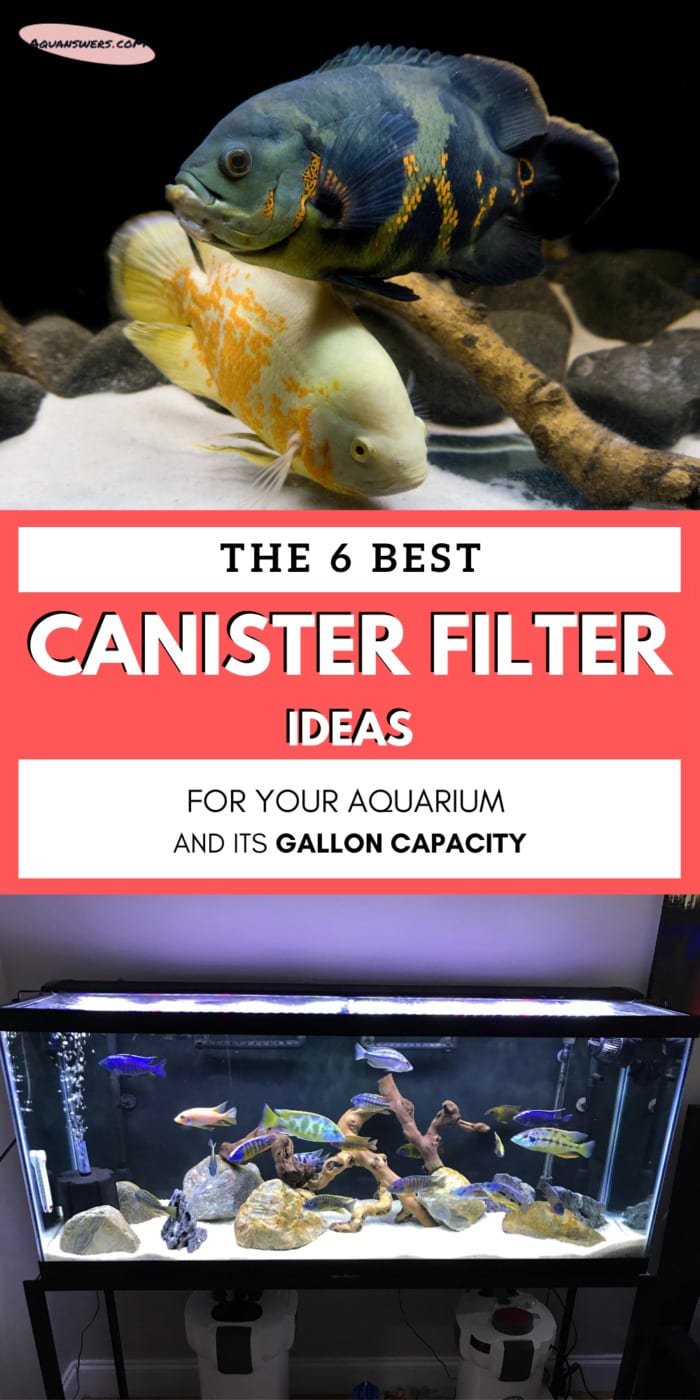



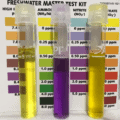

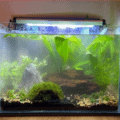

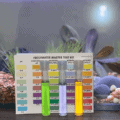

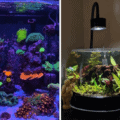

Just wanted to say thank you! I have been agonizing over which filter to get and your articles were clear, concise, and straight to the point. I read through them and felt much better about my decision!
Hi Laura,
I thank you for being a reader! Hope you stay around 🙂
Hello thank you for your nice articles like this and also the one about most quiet filters. Can I please have a question?
I want to start a 35 gallon aquarium with not so many plants. Only on the edges of the aquarium and it will be plants like grass not something big. On the left side there will be “root” of tree and in the middle some small rocks. I want a lot of swimming space for the fish because I want to have a lot of small fish that are active (Pygmy corydoras, Zebra danio, …). And I don’t know if I should get the fluval 207 or fluval 307. On some forum I read that for 30 gallon they recommended 307. But I think that for my setup will be 207 enough.
What do you think?
Thank you very much for your help.
With regards Tomáš Arlt
Hi Tomáš,
It sounds like you want to have lots and lots of small schooling fish, correct?
The 307 model has 206 GPH, which will turn the water in your tank close to 6 times per hour.
This is more than enough for the kind of setup you’re describing.
The 207 Fluval model has 120 GPH, which can also work depending on the bioload (if you don’t overstock, but I guess you want a higher bioload).
Hope this helps!
Yes that’s correct.
Ok I will get the 307, I know where the problem was … I thought that the GPH I was looking for is Pump Performance instead of Filter Circulations. And even our local (czech) vendors had advertised the Pump Performance so I did the math and thought that the 207 will 6x turn the water 😀
Thank you very much for your quick response.
Yes,
Vendors (and Fluval for that matter) don’t make it easy for the user. I think it’s a marketing gimmick, but their products are good nonetheless, so it’s not THAT off-putting.
Good luck! Your future aquarium sounds really cool by the way.
One filter that wasn’t mentioned (which I am most interested in), is the Fluval FX4. Would this filter be good for a 55 gallon tank, medium to fully stocked including 4 pleco’s (2 bristlenose [4-5”] and 2 smaller [3”] albino), a 6” clown loach, 2 Gourami, 3 glo-fish tetras, 5 black skirt tetras, 2 sword tail, 4 mollies, 10 guppy’s, 5 neon tetras, and 3 other small fish (the size of a small guppy), that I can’t remember what they are called. I do plan on getting more fish in the near future.
Right now I have 2 HOB filters (a Fluval 70 and a Fluval 30, that just aren’t enough and I want to get a canister filter that won’t hurt my plants or small fish. I know the Fluval FX6 is overkill, but wondering about the FX4. Can you tell me if that would be good for my tank and if not, what would be the best canister filter for me? Also, I’m really not in to having to prime it or clean it twice a week. Please help and thank you in advance for any info you can give me.
Hello!
Actually, a Fluval FX4 is (more than) twice as powerful as the Fluval 306. It’s honestly a great filter but it will be overkill even if you were keeping something super messy in there such as Oscars, eels or turtles.
The difference between the FX6 and the FX4 is around 100 GPH and that the FX6 has 50% more space for media.
From the fish that you listed only the plecos are a somewhat messy, but it’s not enough for me to recommend and FX for this setup…
If you’re concerned about the overstocking you can go with a Fluval 406/407, but that’s about it in my opinion. Either of these will, in my opinion, take care of the waste pretty well without producing too much turbulence and blowing your smaller fish around.
Hope this helps, Patti.
Good luck!